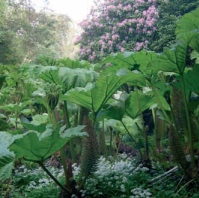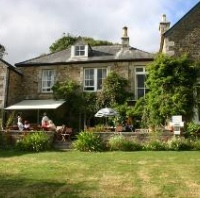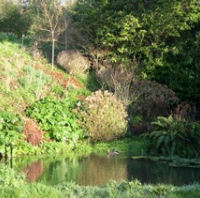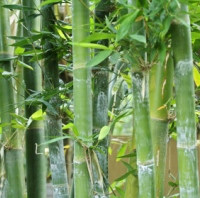- About Us
- Columns
- Letters
- Cartoons
- The Udder Limits
- Archives
- Ezy Reading Archive
- 2024 Cud Archives
- 2023 Cud Archives
- 2022 Cud Archives
- 2021 Cud Archives
- 2020 Cud Archives
- 2015-2019
- 2010-2014
- 2004-2009
 |
An American In Cornwall- |
Click here for Part I- On The Getting To Cornwall
Jane’s response to my proposition about heading across to the United Kingdom was overwhelmingly positive. Yes, I could come to Cornwall, work in her garden, and experience what was to ultimately become my muse, Carwinion.  I tied up the last of my loose ends in America and boarded a British Airways flight to London/Heathrow on November 17th, 2006, hoping and praying that return would not be an option. My parents warned me that Heathrow had changed since the 1980’s and that it was swarming with immigrants, or another human variant, those of desperate furtive movement: tourists. I would contend with this violent clash of culture- a targeted, despised American. I’d need to be consistently aware of myself, my property, and of all persons standing beside, before, behind me. I would be directed by vague and confusing signs herding me onto miles of moving sidewalks, lost in a dystopian, traveling American nightmare. Well, inevitably, none of this transpired. I arrived at eight in the morning and soared through customs by eight forty-five.
I tied up the last of my loose ends in America and boarded a British Airways flight to London/Heathrow on November 17th, 2006, hoping and praying that return would not be an option. My parents warned me that Heathrow had changed since the 1980’s and that it was swarming with immigrants, or another human variant, those of desperate furtive movement: tourists. I would contend with this violent clash of culture- a targeted, despised American. I’d need to be consistently aware of myself, my property, and of all persons standing beside, before, behind me. I would be directed by vague and confusing signs herding me onto miles of moving sidewalks, lost in a dystopian, traveling American nightmare. Well, inevitably, none of this transpired. I arrived at eight in the morning and soared through customs by eight forty-five.
Travel tip: When journeying to or in foreign countries it is more sensible to use an indigenous airline, unless of course, you spy visible signs of duct tape or bailing wire on the fuselage, or aiding and abetting the engines. These airports generally contrive to accommodate, and any monies accumulated in frequent flier miles are rendered useless, when relieved of the horrendous struggles with language, luggage and a lack of sleep. Post-customs, I boarded the Heathrow Express that sped me to Paddington Station by nine fifteen. 3 hours early for my train (this had never happened in Italy), I promptly purchased a newspaper and a cappuccino at Café Reef. Both were good.
Travel Tip: Buy your rail pass online before you travel. I boarded my train at twelve o’clock and began my six-hour journey to Truro, Cornwall. I would have arrived on time had there not been a drunken teenager hanging from the train trestle, or a wayward herd of sheep that found the tracks a most agreeable place to have a meeting.
Jane hadn’t seen me in twenty years, and I was running scenarios that either began or ended with me sleeping on park benches or in the local police station. The three previous years in post-9-11 America had chiseled away at the guiding principle that we are all human; all connected. It took me a couple of weeks to realize that nobody wanted to kill me, nor that swarthy men weren’t going to pull up curbside and make me disappear into the back of a mini-bus.
I was used to the Italian trains, where you often see the conductor on the platform smoking a cigarette, and the train leaves when he’s finished. Or the train stops in the middle of a field, and ten minutes later the crew is seen wading through the tall grass towards a waiting van that has been provided by their union rep. “Sciopero… good luck Americano, we just went on strike”. The English trains -at least the Cornwall leg of my journey- stopped for less than five minutes per station. You had to have your shit together and be prepared to exit one’s compartment, roll down the window, reach outside the car and grab the red handle, pulling up to open the door so as to be able to depart the train. The only other option was to hide behind a local and let them open the door for you. That’s the way I went. I walked down the platform and easily spotted Jane. My adventure in Cornwall had begun.
I was a bit tired, and my stomach was upset from the three Adavan, a tranquilizer of the benzodiazepine family that allows me to fly without being completely inebriated. I love traveling, but hate flying- I only get religious around airplanes. I hadn’t been on a road narrower than a football field in three years, and my position in the back seat added to my discomfort as the car careened around the twisty English roads. I was nauseous and working on a case of the spaghetti sweats. It was all I could do to keep from throwing up in the back of Jane’s car.
I came to in what was described to me as typical Cornish winter weather- ‘mizzle’, Cornish for rain and mist, and lots of wind. Let’s just say that a breeze blows at about forty miles an hour and leave it at that. The house, or rather, mansion I’m staying at is ‘Carwinian’, a large Georgian house built late in the 18th century and added on to in the 1840s.  It was built by the Rogers family- a large local Cornish family who’d made their fortune as solicitors and doctors. The Rogers are part of a larger, wealthier family, the Fox family. The Fox family was into shipping, import/export, and other international types of endeavors. The Foxes were known to have sent out expeditions overseas to find, extract, preserve, and return rare plants that would survive in Cornwall’s sub-tropical climate. The beautiful tree ferns that can, to this day, be found all over Carwinion are said to have come from Australia in the bottom of a ship’s ballast. Apparently a ship that was getting loaded in Australia, about to sail across to Falmouth, Cornwall, (one of the deepest natural harbors in the world), needed some extra weight to keep the keel in the water. On a pier next to the ship were several twisted stumps that had been pulled from the ground in preparation for the construction of a building. These stumps were loaded on, made the long journey across the Atlantic, and were discarded upon arrival. Several days or weeks later someone had noticed several plants sprouting out of the stumps. One of the Foxes apparently planted this profligate, and now the Tree Fern is growing all over the Cornish countryside.
It was built by the Rogers family- a large local Cornish family who’d made their fortune as solicitors and doctors. The Rogers are part of a larger, wealthier family, the Fox family. The Fox family was into shipping, import/export, and other international types of endeavors. The Foxes were known to have sent out expeditions overseas to find, extract, preserve, and return rare plants that would survive in Cornwall’s sub-tropical climate. The beautiful tree ferns that can, to this day, be found all over Carwinion are said to have come from Australia in the bottom of a ship’s ballast. Apparently a ship that was getting loaded in Australia, about to sail across to Falmouth, Cornwall, (one of the deepest natural harbors in the world), needed some extra weight to keep the keel in the water. On a pier next to the ship were several twisted stumps that had been pulled from the ground in preparation for the construction of a building. These stumps were loaded on, made the long journey across the Atlantic, and were discarded upon arrival. Several days or weeks later someone had noticed several plants sprouting out of the stumps. One of the Foxes apparently planted this profligate, and now the Tree Fern is growing all over the Cornish countryside.
I soon discovered that Carwinion is home to one of the finest collections of Bamboo in England. Over 200 different varieties could be found in the 12-acre valley garden, and ranging in height from four inches to thirty-plus feet. The garden was even host to almost 200 European and American members of the European Bamboo Society in August of 2000 (who knew such an organization existed?). The collection had been started some twenty years earlier by a gent named Anthony Rogers. Discouraged by trying to remember the names of the many camellias in the garden, he thought he would like to try something different. It remains a mystery as to why he would have found Schizostachyrus Fungomii or Hibano-Bambusa Tranquilans “Shiroshima” easier to remember or pronounce, but his very fine collection remains to this day a feast for experts or novices alike.
The garden was, in Anthony’s words, ‘unmanicured’. It had to be that way- the days of when fifteen gardeners were employed on the estate were long gone and so it was now tended to by Anthony’s wife Jane, the indispensable Chris Bosworth, and Alex Davies. It was also, as of that week, to be tended to by one recent American arrival- me. Ponds and streams upon whose banks could be found some quite spectacular specimens welcomed me. A huge Dramas Winteri, a stunning sight in the Spring. An enormous grove of Gunnera Manicata, whose ten-foot wide leaves questioned and redefined one’s sense of scale. The sides of the valley were filled with large Rhododendrons among which -slightly incongruously- grew Chusan Palms. An old quarry, from which came the stone to build Carwinion, was full of tree ferns and contained one of the finest bamboos in the garden- Drepanostachyum Falcatum. On the west side was a tiny valley-now the Japanese Garden-full of acres and everything Japonica that might possibly be crammed in, and overlooked by a very big Musa Badjo and some fine Semiarundinaria Fatuosa. The difference between the species of bamboo was amazing.
Bamboo is many things to many people. It is incredibly strong and thus used in the manufacture of weapons, scaffolding, and truss. In the pages of magazines and books we’ve often seen it used to support buildings, just as westerners use scaffold and the British use cold rolled steel. I was keen on bamboo until asked to transplant some on the third day of my time in Carwinion and amid the ongoing ‘mizzle’. I’m not exactly small and it seemed that while I was sleeping off my jetlag post arrival that Jane had expanded her plans for Carwinion. In addition to the usual daunting list of tasks that the poor motherfuckers looking after things had to do to keep the ‘unmanicured’ garden in good condition, Jane decided that she was going to create a nursery by the green houses that served as an incubator to grafts, clippings, and sensitive plants. Chris, the head gardener, a diminutive fellow, handsome with hair all evenly gray, handed me what appeared to be an edging shovel.
I was keen on bamboo until asked to transplant some on the third day of my time in Carwinion and amid the ongoing ‘mizzle’. I’m not exactly small and it seemed that while I was sleeping off my jetlag post arrival that Jane had expanded her plans for Carwinion. In addition to the usual daunting list of tasks that the poor motherfuckers looking after things had to do to keep the ‘unmanicured’ garden in good condition, Jane decided that she was going to create a nursery by the green houses that served as an incubator to grafts, clippings, and sensitive plants. Chris, the head gardener, a diminutive fellow, handsome with hair all evenly gray, handed me what appeared to be an edging shovel.
“Ave had it mate’
I took my time reaching out to grab the shovel without wanting to appear overly ambitious in any sense.
“What kind of shovel is that? I mean it doesn’t look like it’s made for digging.”
“It’s a Cornish Spade mate, multi purpose, good for ‘cuttin’, and shovlin’ coal”
Chris went on to describe accurately and eloquently how to find the absolute end of the bamboo root, cut it off, using the spade as a hoe, a knife, shovel, pry bar, and cudgel. It took me forty-five minutes to take out a medium sized clump, and the experience left me drained. Bamboo would become a formidable adversary that I’d alternately hate, love, and ultimately try to understand as a plant, symbol, and religion. Jane envisioned transplanting fifty or sixty of them. 
I worked with the crew in the garden three days a week, learning about the different plants and contributing my skills under Jane and Chris’ supervision. In this milieu, I was truly lucky. I had the unique opportunity to learn about plants and gardening and work closely with Chris and Alex. This allowed me to begin a unique cultural exchange because, as we know, when you get down to working with somebody you get the chance to see him or her in a different light. You can work with someone all your life in an office and never get to know them, but in the great outdoors, using power tools, blood, and sweat, one can achieve a different bond. Not only does one acquire a firsthand knowledge of the naughty words and epithets as we “get close” or “talk to” our work, but Chris and Alex also did me a great service by imparting their knowledge of all things local. Like the prize winning local vineyard, Camel Valley. Camel Valley actually beat the Italians and the French at competition the previous year in the sparkling wine categories, but of this I can speak more on in subsequent articles. There were also a dizzying array of local cheeses to be discovered but again, I can talk more of that later as well.
For now I’m done, but I would like you to stay with me in coming issues as I tell of my dance through all things Cornish...
